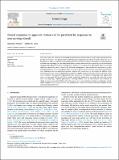Files in this item
Neural responses to apparent motion can be predicted by responses to non-moving stimuli
Item metadata
| dc.contributor.author | Poncet, Marlene | |
| dc.contributor.author | Ales, Justin Michael | |
| dc.date.accessioned | 2020-06-23T13:30:01Z | |
| dc.date.available | 2020-06-23T13:30:01Z | |
| dc.date.issued | 2020-09 | |
| dc.identifier | 268056002 | |
| dc.identifier | 9719af00-318a-4ff1-8fea-b75c55199d0d | |
| dc.identifier | 85085614200 | |
| dc.identifier | 000555460300010 | |
| dc.identifier.citation | Poncet , M & Ales , J M 2020 , ' Neural responses to apparent motion can be predicted by responses to non-moving stimuli ' , NeuroImage , vol. 218 , 116973 . https://doi.org/10.1016/j.neuroimage.2020.116973 | en |
| dc.identifier.issn | 1053-8119 | |
| dc.identifier.uri | https://hdl.handle.net/10023/20129 | |
| dc.description | Funding: UK BBSRC grant BB/N018516/1 (JMA). | en |
| dc.description.abstract | When two objects are presented in alternation at two locations, they are seen as a single object moving from one location to the other. This apparent motion (AM) percept is experienced for objects located at short and also at long distances. However, current models cannot explain how the brain integrates information over large distances to create such long-range AM. This study investigates the neural markers of AM by parcelling out the contribution of spatial and temporal interactions not specific to motion. In two experiments, participants’ EEG was recorded while they viewed two stimuli inducing AM. Different combinations of these stimuli were also shown in a static context to predict an AM neural response where no motion is perceived. We compared the goodness of fit between these different predictions and found consistent results in both experiments. At short-range, the addition of the inhibitory spatial and temporal interactions not specific to motion improved the AM prediction. However, there was no indication that spatial or temporal non-linear interactions were present at long-range. This suggests that short- and long-range AM rely on different neural mechanisms. Importantly, our results also show that at both short- and long-range, responses generated by a moving stimulus could be well predicted from conditions in which no motion is perceived. That is, the EEG response to a moving stimulus is simply a combination of individual responses to non-moving stimuli. This demonstrates a dissociation between the brain response and the subjective percept of motion. | |
| dc.format.extent | 13 | |
| dc.format.extent | 1772071 | |
| dc.language.iso | eng | |
| dc.relation.ispartof | NeuroImage | en |
| dc.subject | Apparent motion | en |
| dc.subject | EEG | en |
| dc.subject | Long-range | en |
| dc.subject | Short-range | en |
| dc.subject | Spatio-temporal interactions | en |
| dc.subject | RC0321 Neuroscience. Biological psychiatry. Neuropsychiatry | en |
| dc.subject | DAS | en |
| dc.subject | BDC | en |
| dc.subject.lcc | RC0321 | en |
| dc.title | Neural responses to apparent motion can be predicted by responses to non-moving stimuli | en |
| dc.type | Journal article | en |
| dc.contributor.sponsor | BBSRC | en |
| dc.contributor.institution | University of St Andrews. School of Psychology and Neuroscience | en |
| dc.identifier.doi | https://doi.org/10.1016/j.neuroimage.2020.116973 | |
| dc.description.status | Peer reviewed | en |
| dc.identifier.grantnumber | BB/N018516/1 | en |
This item appears in the following Collection(s)
Items in the St Andrews Research Repository are protected by copyright, with all rights reserved, unless otherwise indicated.

